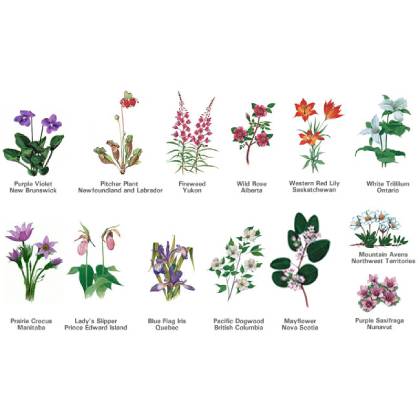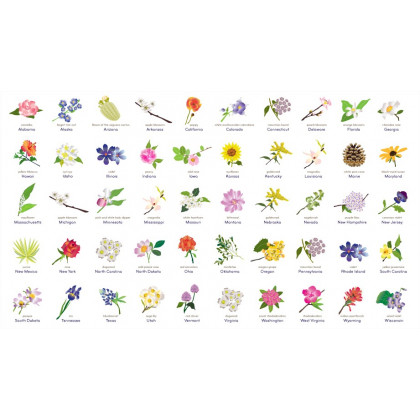Learn about the 14 different flowers from each Province in Canada, listed from Alberta to the Yukon.
Alberta (Wild Rose): Alberta adopted the wild rose (Rosa acicularis) as its official flower in 1930. The editor of an Edmonton newspaper suggested that a provincial floral emblem be selected. The Women’s Institutes took up the suggestion and passed it on to the Department of Education, and the province’s schoolchildren made the final choice.
https://www.canada.ca/en/immigration-refugees-citizenship/services/canadians/celebrate-being-canadian/teachers-corner/pin-symbol-province-territory/fact-sheet-alberta.html
British Columbia (Pacific Dogwood): The Pacific dogwood (Cornus nuttallii) was adopted in 1956 as B.C.'s floral emblem. The Pacific Dogwood is a tree that grows six to eight metres high, and flowers in April and May. In the autumn, it's known for its cluster of bright red berries and brilliant foliage. It is illegal to pick dogwood flowers in B.C.
https://www2.gov.bc.ca/gov/content/governments/celebrating-british-columbia/symbols-of-bc#flower
Prince Edward Island (Lady’s Slipper): The lady’s slipper (sp. Cypripedium) was designated as provincial floral emblem on April 25, 1947. It is an orchid whose petals form a small bag reminiscent somewhat of the shape of a hoof, hence its name. It flowers in late May and June, and grows mostly in shaded woodlands. This delicate flower should not be picked or moved since it rarely survives a habitat change.
https://www.princeedwardisland.ca/fr/information/bureau-du-conseil-executif/fleur-emblematique
Manitoba (Prairie Crocus): In Manitoba, the prairie crocus (Pulsatilla ludoviciana)—also known as anemone patens, the pasque-flower, the windflower (because of its furry petals) and the gosling plant—was officially adopted as the official flower in 1906. Interest had first been aroused by the Manitoba Horticultural Society. A subsequent vote among schoolchildren put the crocus in first place, the prairie lily second and the wild rose third.
https://www.canada.ca/en/immigration-refugees-citizenship/services/canadians/celebrate-being-canadian/teachers-corner/pin-symbol-province-territory/fact-sheet-manitoba.html
New Brunswick (Violet): The purple violet (Viola cucullata) was adopted as New Brunswick’s official flower in 1936, based on input from the Women’s Institute, the Lieutenant Governor and the province’s schoolchildren. The flowers of the purple violet have been used in jams and syrups, and are believed to have properties to soothe the digestive tract and suppress a cough.
https://www.canada.ca/en/canadian-heritage/services/provincial-territorial-symbols-canada/new-brunswick.html#a6
Newfoundland and Labrador (Pitcher Plant): The insect-eating pitcher plant (Sarracenia purpurea L.) was adopted as Newfoundland and Labrador’s floral emblem in 1954. It is the most unusual of Canada’s official flowers. It was first chosen as a symbol of Newfoundland by Queen Victoria, to be engraved on the newly-minted Newfoundland penny. It was used on the island's coinage until 1938.
https://www.canada.ca/en/canadian-heritage/services/provincial-territorial-symbols-canada/newfoundland-and-labrador.html#a6
Northwest Territories (Mountain Avens): The Northwest Territories floral emblem, the mountain avens (Dryas octopetala), was adopted in 1957. The creamy-white flower, which is a member of the rose family, grows in the Eastern and Central Arctic on high, barren rocky ground. It has narrow basal leaves, and supports a single bloom on a short stem.
https://www.canada.ca/en/canadian-heritage/services/provincial-territorial-symbols-canada/northwest-territories.html#a5
Nova Scotia (Mayflower): Nova Scotia adopted the trailing arbutus or mayflower (Epigaea repens L) as its official flower in 1901, when an Act of the provincial legislature stated that it “is hereby declared to be and from time immemorial to have been the emblem of Nova Scotia.” As far back as 1825, it was used as a decorative motif on the front page of the Nova Scotian. During the 19th century, it appeared on the buttons of the Nova Scotia militia; it also appeared on postage stamps along with the rose, the thistle and the shamrock.
https://www.canada.ca/en/immigration-refugees-citizenship/services/canadians/celebrate-being-canadian/teachers-corner/pin-symbol-province-territory/fact-sheet-nova-scotia.html
Nunavut (Purple Saxifrage): Nunavut’s floral emblem, the purple saxifrage (Saxifraga oppositifolia), was unanimously adopted by the Legislative Assembly of Nunavut in 2000. This wildflower is one of the three flowers depicted on the coat of arms of Nunavut. One of the first plants to flower in the Arctic spring, the purple saxifrage often grows together across the tundra; it provides a vivid, purple contrast to the snow that is often present when they flower.
https://www.canada.ca/en/canadian-heritage/services/provincial-territorial-symbols-canada/nunavut.html#a6
Ontario (White Trillium): The white trillium (Trillium grandiflorum), also known as the wake-robin and the white lily, was officially adopted as Ontario’s floral emblem in 1937. It was recommended by a special committee of botanists to the Ontario Horticultural Association. In a British botanical work published in 1760 there is a reference to the trilliums as “the herb True Love of Canada.”
Ontario (trille blanc): Le trille blanc (Trillium grandiflorum), également connu sous le nom de sillage de robinier et de lis blanc, a été officiellement adopté comme emblème floral de l'Ontario en 1937. Il a été recommandé par un comité spécial de botanistes de la Ontario Horticultural Association. . Un ouvrage botanique britannique publié en 1760 mentionne les trilles comme «l'herbe véritable amour du Canada».
https://www.canada.ca/en/canadian-heritage/services/provincial-territorial-symbols-canada/ontario.html#a6
Quebec (Iris): The blue flag (Iris versicolor) is the floral emblem of Quebec, as per An Act respecting the flag and emblems of Québec, which came into force on November 5, 1999. An indigenous spring flower, the blue flag grows on over half of Quebec's territory, from the St. Lawrence Valley to the shores of James Bay. From 1963 to 1999, the white garden lily was the floral emblem of Quebec.
https://www.canada.ca/en/canadian-heritage/services/provincial-territorial-symbols-canada/quebec.html#a6
Saskatchewan (western red lily): Saskatchewan’s floral emblem, the western red lily (Lilium philadelphicum), was officially adopted in 1941. The Saskatchewan Natural History Society suggested the flower to a special committee created to consider the matter. The flower is a protected species and grows in moist meadows and semi-wooded areas. It stands out brilliantly with its flaming red blossoms against a natural green background.
https://www.canada.ca/en/canadian-heritage/services/provincial-territorial-symbols-canada/saskatchewan.html#a6
Yukon (Fireweed): Fireweed (Epilobium angustifolium) was chosen as Yukon’s floral emblem in 1957. It is a hardy plant and grows along Yukon roadsides, river bars and clearings from mid-July to September. Its blooms are a bright magenta, making it one of the most attractive plants in the North. It’s also one of the first plants to appear after a forest fire.
https://www.canada.ca/en/canadian-heritage/services/provincial-territorial-symbols-canada/yukon.html#a5
 | SAME DAY DELIVERY AVAILABLE FOR ORDERS PLACED BEFORE 14H
| SAME DAY DELIVERY AVAILABLE FOR ORDERS PLACED BEFORE 14H


Leave Your Comment